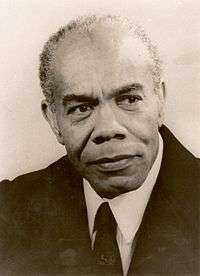Henri Frans de Ziel
Trefossa, pen name of Henri Frans de Ziel (15 January 1916 – 3 February 1975), was a neoromantic writer in Dutch and Sranan Tongo from Suriname. He is best known for the Sranan Tongo stanzas of Suriname's National Anthem.[1]
Trefossa | |
|---|---|
 | |
| Born | Henri Frans de Ziel 15 January 1916 |
| Died | 3 February 1975 (aged 59) |
| Nationality | Dutch |
| Occupation | writer, poet, teacher |
Notable work | God zij met ons Suriname (Suriname's National Anthem) |
Biography
He was an educator and lived in the Netherlands from 1953 to 1956.[2] Upon his return to Suriname he was part of the editorial staff of the magazines Tongoni (1958-1959) and Soela (1962-1964).[3] He also served briefly as the director-librarian of Suriname's Cultural Centre (Cultureel Centrum Suriname (CCS)).[2] He subsequently returned to the Netherlands to work on the publication of Johannes King's memoirs.[3]
Trefossa wrote primarily about the beauty of his native country, Suriname, especially as a source of peace to the restless mind. He influenced many writers in Suriname, including Corly Verlooghen, Eugène Rellum, Johanna Schouten-Elsenhout and Michaël Slory, but the depth and subtlety of his verse remain almost unique.[4]
Trefossa was annoyed about the negative nuance in the National Anthem at time, and started to transform the second stanza into a positive message. Trefossa combined this with a poem he wrote in Sranan Tongo on the death of Ronald Elwin Kappel.[5] His anthem was unanimously approved by the Government of Suriname on 7 December 1959.[1]
In 1969, his health started to deteriorate, and he was admitted to the sanatorium Zonnedaal in Bloemendaal. Here he met his wife, Hulda Walser, whom he married in 1970. On 3 Februari 1975, de Ziel died in Haarlem.[4]
On 21 November 2005, a monument was dedicated in his honour on the Sophie Redmondstraat in Paramaribo. His ashes and the ashes of his wife, Hulda Walser, were also placed at the monument.[4]
Poem
The poem by Trefossa, referenced in the external link about the mural at the bottom, is translated from Sranan into English below:
| Gronmama | Earthmother |
|---|---|
| Mi a no mi
solanga mi brudu |
I am not myself
until my blood |
| Mi a no mi
solang mi lutu |
I am not myself
until my roots |
| Mi a no mi
solang m'no krari |
I am not myself
until I manage |
| Mi a no mi
solanga y' n'e bari |
I am not myself
until you cry out |
References
- "Trefossa en het volkslied van Suriname". Star Nieuws (in Dutch). Retrieved 19 May 2020.
- H.F. de Ziel, Digital Library for Dutch Literature. "Ala poewema foe Trefossa". Retrieved 19 May 2020.
- Shrinivási, Digital Library for Dutch Literature. "Wortoe d'e tan abra". Retrieved 19 May 2020.
- "Herdenking 40ste sterfdag van Trefossa". Dagblad De West (in Dutch). Retrieved 19 May 2020.
- "ASN Wikibase Occurrence # 163559". Aviation Safety. Retrieved 19 May 2020.
Sources
- Michiel van Kempen: Een geschiedenis van de Surinaamse literatuur. De Geus, Breda 2003, ISBN 90-445-0277-8.
According to the Dutch page of this article, Michiel van Kempen has given Wikipedia permission to use the above mentioned work.
External links
- H.F. de Ziel at Digital Library for Dutch Literature (Ala poewema foe Trefossa, a biography in Dutch, is available as free download)
- Trefossa at Werkgroup Caraïbische Letteren
- (in Dutch) Mural in Leiden